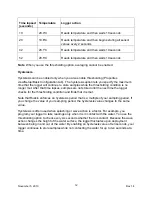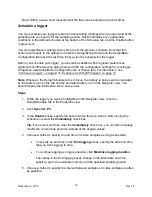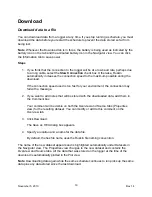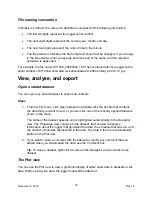
Steps
1. While the logger you want is highlighted in the Navigator view, click the
Setup/Basic
Configuration
tab in the Properties view.
2. If you want to connect another instrument to the deployed logger to “listen” to the logger
and take action under certain conditions, or while still connected to the logger you want
to view a graphical display of the live data samples taken according to your schedule,
select the
Enable streaming data
check box. We recommend that you also select the
Enable data storage
whilst streaming check box so that the data will not be lost.
For more information, see
“Fetching and streaming data” on page 18
.
3. If you want your logger to convert raw data to printable ASCII characters in an
engineering format before transmitting it, select the
Enable engineering units
output
check box.
Note
: Although the data stored on the logger is of the highest precision, some precision
may be lost if you use the data in the Plot view because Ruskin converts the data back
to the raw format.
4. If you can see your logger case while it is deployed and want a visual indication that the
logger is running, select the
Enable sampling LED
check box. This LED does consume
battery power.
The LED will flash when sampling.
Note
: Your logger may not support this feature.
5. Under the
Setup/Waves
tab, in the
Tidal sampling period
box, specify the interval that
you want between samples.
Note
: If you change this value, any value in the Wave sampling period box changes
automatically so that it remains the same number of multiples of this value. For more
information, see “Relationship between the tidal and wave sampling periods” on page
15.
6. If you want to use the average of multiple readings rather than take a single reading for
each sensor for a tidal sampling period, do the following:
•
Select
the
Enable tidal averaging
check box.
•
Specify the tidal averaging duration. The tidal averaging duration must be shorter
than the tidal sampling period. For more information, see “Averaging” on page
11.
•
Specify the rate in Hz at which you want to take tidal samples.
November 5, 2010
Rev1.4
14
















































